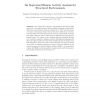250 search results - page 38 / 50 » Occlusion tracking using logic models |
PR
2002
13 years 7 months ago
2002
Many approaches can track objects moving in sequences of images but can su er in occlusion and noise, and often require initialisation. These factors can be handled by techniques ...
FUZZIEEE
2007
IEEE
14 years 1 months ago
2007
IEEE
— This paper presents the fuzzy video based emotion recognition system VISBER, that allows to analyze facial expressions in video sequences. In order to process images in real-ti...
ISVC
2010
Springer
13 years 5 months ago
2010
Springer
We consider the problem of developing an automated visual solution for detecting human activities within industrial environments. This has been performed using an overhead view. Th...
VMCAI
2010
Springer
14 years 4 months ago
2010
Springer
Tracking subset relations between the contents containers on the heap is fundamental to modeling the semantics of many common programing idioms such as applying a function to a sub...
WACV
2005
IEEE
14 years 28 days ago
2005
IEEE
This paper presents an automatic Australian sign language (Auslan) recognition system, which tracks multiple target objects (the face and hands) throughout an image sequence and e...

